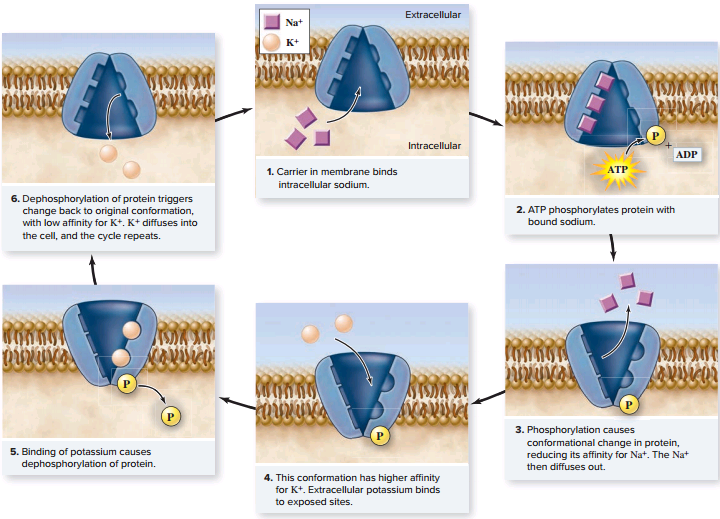Movement of Molecules Across Cell Membranes by Active Transport
Diffusion,facilitated diffusion, and osmosis are all passive transport processes that move materials down their concentration gradients(from higher concentration to the lower concentration). However,to gather food molecules and other substances,
cells must also be able to move substances across the plasma membrane up their concentration gradients(from lower concentration to the higher concentration). This process requires the expenditure of energy, typically in the form of ATP, and is therefore called active transport.
Active Transport Utilities Specific Carrier Proteins
Active transport uses energy to power the movement of materials across a membrane against a concentration gradient. Like facilitated diffusion, active transport involves highly selective protein carriers within the membrane that bind to the transported substance, typically an ion, a sugar, an amino acid, or a nucleotide.
Uniporters
The carrier proteins are called uniporters if they transport a single type of molecule.
Symporters
The carrier proteins that transport two different molecules together are known as symporters or antiporters. Symporters transport two molecules in the same direction, and antiporters transport two molecules in opposite directions. These terms are also sometimes used to describe facilitated diffusion carriers.
Active transport is one of the most important activities carried out by a cell. It enables the cell to take up additional molecules of a substance that is already present in its cytoplasm in concentrations higher than in the extracellular fluid. Active transport also enables a cell to move substances out of its cytoplasm and into the extracellular fluid, despite higher external concentrations.The use of energy from ATP in active transport can be direct or indirect. Let’s first consider how ATP is used directly to move ions against their concentration gradients.
The Sodium-Potassium Pump
More than one-third of all the energy expended by an animal cell that is not actively dividing is used in the active transport of sodium (Na+) and potassium (K+) ions. Most animal cells have a low internal concentration of Na+, relative to their surroundings, and a high internal concentration of K+. They maintain these concentration differences by actively pumping Na+ out of the cell and pumping K+ in.
The remarkable protein that transports these two ions across the cell membrane is known as the sodium–potassium pump. This antiporter carrier protein uses the energy stored in ATP to power the simultaneous movement of these two ions by changing the conformation of the carrier protein, which in turn changes its affinity first for Na+ ions and then for K+ ions. This is an excellent illustration of how subtle changes in the shape of a protein affect its function.
The most important characteristic of the sodium–potassium pump is that it is an active transport mechanism, transporting
Na+ and K+ from areas of low concentration to areas of high concentration. This transport is the opposite of passive transport by diffusion, and it can be achieved only by the constant
expenditure of metabolic energy. The sodium–potassium pump works through the following series of conformational changes in the antiporter transmembrane protein, summarized in figure below.
Step 1. Three Na+ bind to the cytoplasmic side of the protein, causing the protein to change its conformation.
Step 2. In its new conformation, the protein binds a molecule of ATP and cleaves it into adenosine diphosphate (ADP) and phosphate (Pi).ADP is released, but the phosphate group is covalently linked to the protein. The protein is now phosphorylated.
Step 3. The phosphorylation of the protein induces a second conformational change in the protein. This change translocates the three Na+ across the membrane, so they now face the exterior. In this new conformation, the protein has a low affinity for Na+, and the three bound Na+ break away from the protein and diffuse into the extracellular fluid.
Step 4. The new conformation has a high affinity for K+, two of which bind to the extracellular side of the protein as soon as it is free of the Na+.
Step 5. The binding of the K+ causes another conformational change in the protein, this time resulting in the hydrolysis of the bound phosphate group.
Step 6. Freed of the phosphate group, the protein reverts to its original shape, exposing the two K+ to the cytoplasm. This conformation has a low affinity for K+, so the two bound K+ dissociate from the protein and diffuse into the interior of the cell. The original conformation has a high affinity for Na+. When these ions bind, they initiate another cycle.
In every cycle, three Na+ leave the cell and two K+ enter. The changes in protein conformation that occur during the cycle are rapid, enabling each carrier to transport as many as 300 Na+ per second. The sodium–potassium pump appears to exist in all animal cells, although cells vary widely in the number of pump proteins they contain.
Press the Bell-icon and Subscribe
Press the Bell-icon and Subscribe









No comments:
Post a Comment